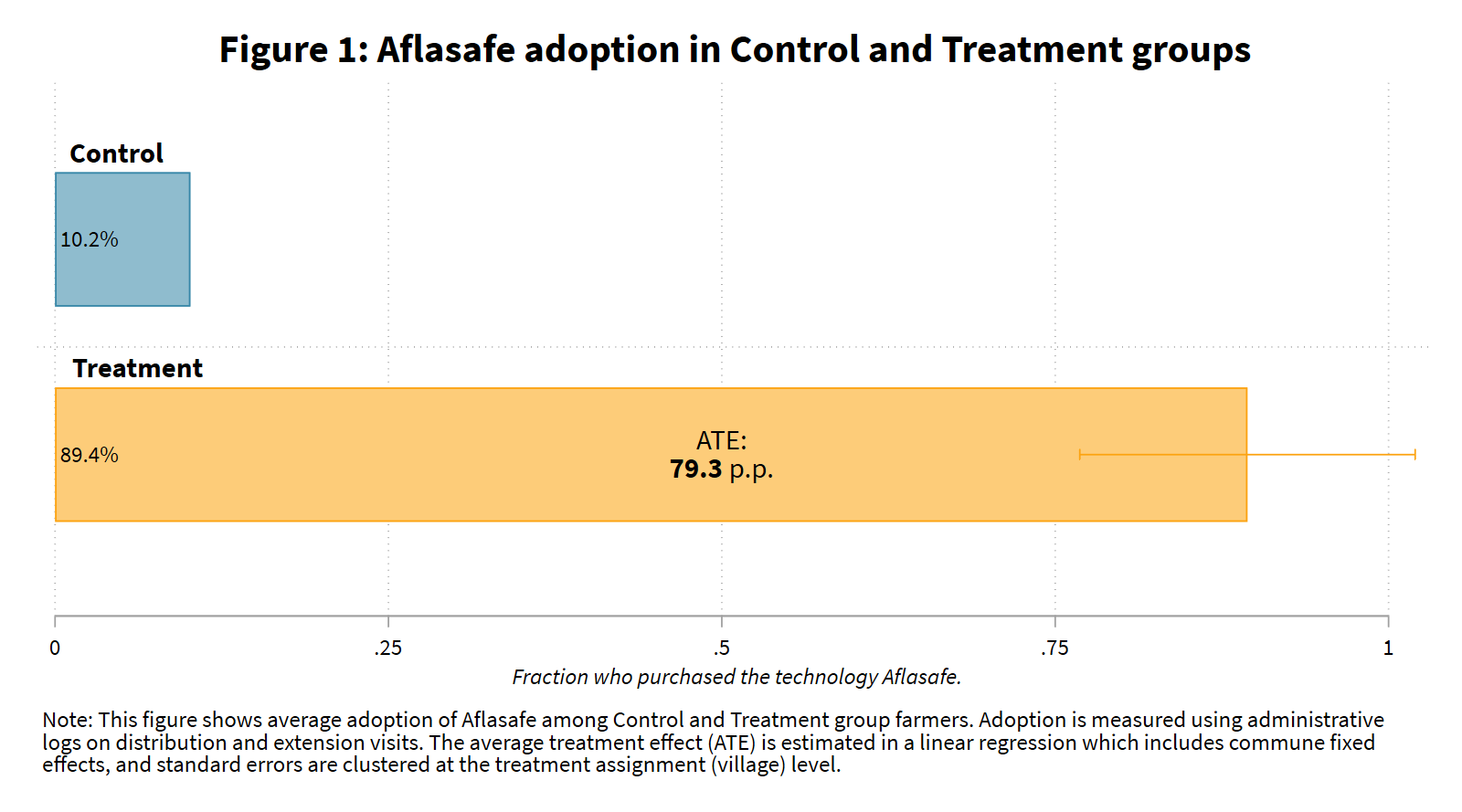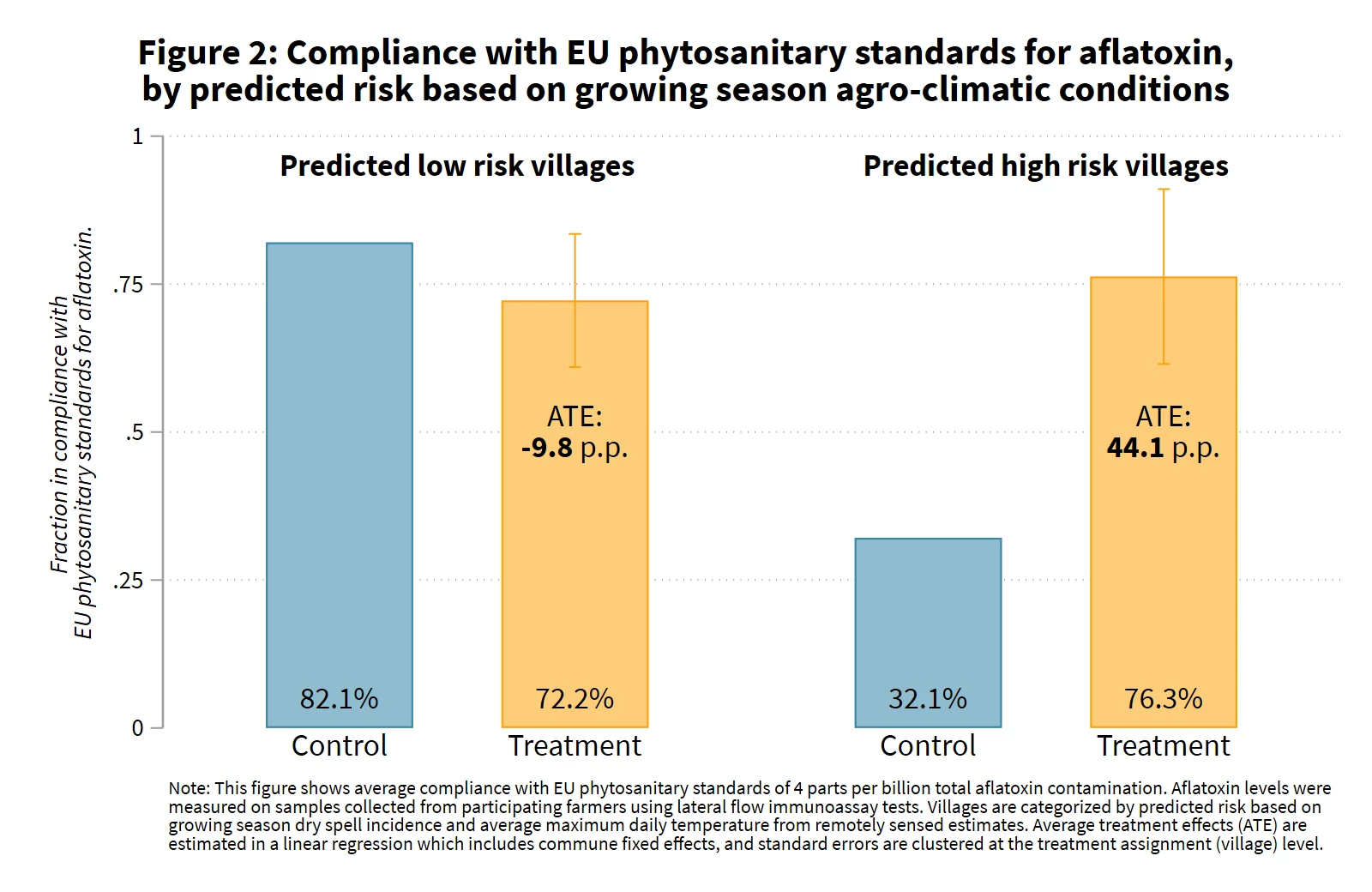This is the second in this year's series of posts by students on the job market.
Smallholder farmers often struggle to meet the quality standards necessary to participate in international markets (2020 World Development Report). New technologies to improve quality may help, but many farmers are unaware of the technologies and how to use them, have limited access to credit to buy them, and may be uncertain they can earn a higher price for better quality production. In my job market paper, my co-authors and I develop and test a new contracting arrangement designed to address these constraints simultaneously. Our results show that this contracting arrangement can indeed help farmers meet export standards by enabling and encouraging use of a quality-improving technology.
Groundnuts and aflatoxins
Groundnut exports are important to Senegal’s economy, but those exports are constrained by aflatoxin quality standards. Aflatoxins are a known “class 1” carcinogen (IARC 2012), and many export markets set strict aflatoxin standards for food safety. Aflatoxins are a serious problem in Senegal: we found in some areas that nearly 50% of tested groundnut samples exceeded food safety standards, making them both dangerous for consumption and difficult to sell for export. Groundnuts use more than 40% of cultivated land in Senegal and are at once the most valuable agricultural export and widely consumed locally. High levels of contamination may significantly affect both the health and incomes of rural producers.
Agronomists at the International Institute of Tropical Agriculture have recently developed an innovative new technology to prevent aflatoxin contamination, which is caused by a toxin-producing fungus found in soil. The technology, named Aflasafe, uses bio-control to protect crops from aflatoxins. Aflasafe works a bit like a vaccine, using non-toxin-producing (atoxigenic) variants of the same fungus that would normally produce aflatoxin. These atoxigenic fungi “take over” the field and inoculate it against the toxigenic fungus. Importantly, use of Aflasafe has not been found to affect crop yields.
When developing this project, we spoke to groundnut buyers eager to source and pay a premium for groundnuts that could meet international food safety standards. However, the median groundnut farmer in our sample only produces about three tons of groundnuts per year, whereas buyers typically evaluate quality and purchase groundnuts at a much larger scale. Many groundnut farmers in Senegal are members of cooperatives, which might serve as a valuable intermediary in this case. In their existing model, these cooperatives typically aim to provide their members with credit to purchase inputs, extension training, and a guaranteed market for their output. If cooperatives could tweak that model to help farmers meet export standards, they could aggregate enough output to deal directly with exporters and help farmers earn a better price.
What did we do?
We designed a new contract offer for farmers to address three key constraints: credit, information about using the technology (Aflasafe), and uncertainty about the price available for higher-quality production. First, the offer included credit to buy Aflasafe, repayable after harvest. Second, the offer included a promise of extension support from the cooperative to ensure farmers knew how to apply Aflasafe correctly. Third, the offer included a guaranteed minimum price premium of about $0.07/kg over the standard cooperative price, conditional on the results of an aflatoxin test.
We implemented the contract in partnership with two large cooperatives in the groundnut basin of Senegal. We randomly sampled 40 villages and 10 members per village. We randomly assigned 20 villages to receive this contract offer, whereas the other 20 villages were simply informed about Aflasafe and eligible to purchase it. Before making the offer, we provided all farmers with information about aflatoxin, including how it develops on crops, the health consequences of consuming contaminated crops, and the potential economic benefits of reducing contamination. Finally, we introduced Aflasafe to farmers, using a standard script and a short video demonstration. All farmers in the study were eligible to purchase Aflasafe at the cooperative’s shop at market price (about $17 USD).

Did farmers choose to purchase Aflasafe?
Our contract offer was sufficient to achieve high levels of technology adoption among participating farmers. We assess this outcome using administrative data on Aflasafe distribution shared by our partner cooperatives. Figure 1 shows average rates of adoption in treatment and control groups. In the control group, where farmers had access to buy Aflasafe but otherwise experienced “business as usual,” about 10 percent of farmers decided to purchase it. By comparison, nearly 90 percent of farmers in the treatment group who received the contract offer decided to purchase Aflasafe.
Did farmers increase the quality of their production?
We find that farmers in the treatment group were about 12% more likely to produce groundnuts that complied with the strictest international aflatoxin standards. We assess this outcome using samples collected from participating farmers and lateral flow immunoassay aflatoxin test kits. Our results confirm that aflatoxin contamination is a problem in our setting: 34% of farmers in the control group showed contamination exceeding EU standards. In the treatment group, contamination rates after the project were lower, but 26% of farmers still exceeded EU standards, suggesting there may be room for complementary interventions to further increase quality.
Underneath the average effect, we find that production quality increases the most in areas which would otherwise be at highest risk of contamination. Aflatoxin levels can vary quite a bit based on growing season conditions like temperature and rainfall (Bowen and Hagan 2015). In the control group villages, some areas in our sample experienced very low levels of contamination, whereas in other areas nearly 50% of the samples we tested were contaminated. Using remotely-sensed estimates from CHIRPS and Copernicus LST-10 datasets, we establish that growing-season conditions affected aflatoxin levels in control villages. We use this result to generate a village-level prediction of aflatoxin risk in our entire dataset. As Figure 2 shows, we find that our treatment is most effective in predicted high-risk villages, increasing compliance with standards by 44 percentage points.

Would a cooperative or intermediary want to implement this contract?
We show that our contract design resulted in increased output sales to the cooperative. This is an important outcome for policy: if farmers were to accept the contract and use the credit to buy Aflasafe, and then sell their output elsewhere, cooperatives or other buyers would not be interested in implementing this contract in the future. We find that farmers in the treatment group are significantly more likely to sell output to the cooperative, and that the quantity they choose to sell to the cooperative increases. In the paper, we discuss heterogeneity in this outcome which is suggestive of the underlying mechanisms. We show that a farmer’s intrinsic reciprocity and the value of the relationship between the farmer and the cooperative are important predictors of heterogeneous treatment effects. These mechanisms are important for intermediaries interested in contracting with farmers in contexts where the prospects for formal contract enforcement are low.
What’s the takeaway message here?
We show that contracts which address multiple possible constraints (credit, information, price uncertainty) can be effective at increasing technology adoption and production quality. We show that agro-climatic conditions matter when assessing the impact of technology adoption on quality in the context of aflatoxin contamination. And we show that contracts between farmers and cooperatives are most effective when farmers are highly reciprocal or seem to value the relationship highly. However, the contract we implemented is also relatively expensive to administer. Could a cheaper contract succeed as well? This will be an avenue we explore in future research.
Joshua Deutschmann is a PhD candidate in Agricultural and Applied Economics at the University of Wisconsin-Madison. More details about his research can be found here (https://jwdeutschmann.com).


Join the Conversation